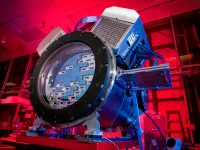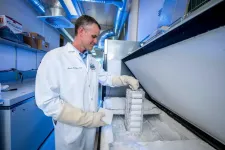(Press-News.org) SAN ANTONIO (May 27, 2021) -- One-fifth of babies who inherit a genetic variant located on chromosome 16 will develop autism spectrum disorder (ASD) by age 3. The variant is called 16p11.2 deletion.
Noboru Hiroi, PhD, of The University of Texas Health Science Center at San Antonio (also referred to as UT Health San Antonio), is studying mice that have this deletion. The team, which includes colleagues from Japan, Ireland and the U.S., is harnessing the power of machine learning to understand which vocalizations of the newborn mouse pups are most predictive of social abnormalities one month later when the pups reach puberty.
"It is essential to identify those very early signs that can predict what is to come, because if we can translate what we discover in mouse pups to human infants and apply therapeutic options earlier, their outcome will be better," Dr. Hiroi said.
Mice are studied because of the short timeline of their development. The same research in human babies, which is just beginning, will take two to three years of follow-up. In May, collaborators led by Cynthia Blanco, MD, professor of pediatrics and the Greehey Family Foundation Chair in Neonatology Research at UT Health San Antonio, started recording the cries of preterm infants in the University Hospital neonatal intensive care unit. Preterm infants are targeted because of their high risk of developmental issues, including ASD.
Disordered cries
When mouse pups are separated from their mothers, they emit ultrasonic vocalizations in a certain order. Mouse mothers respond to the cries and take care of their offspring.
The cries are abnormal in mice with the 16p11.2 deletion.
"Pups that carry this genetic variation cannot form the correct sequence," Dr. Hiroi said. "We want to know whether those abnormal sequences or combinations of call types can predict what is to come one month later in their social behaviors."
Machine learning will enable the team to develop a precise diagnostic algorithm for ASD. "The point is, once we can do this with the mouse vocalizations, we can apply the same algorithm to the cries of human babies," Dr. Hiroi said.
Earlier intervention
Infants at risk of ASD who are identified in this way can be given desensitization therapy so that they don't overreact to certain cues they don't like, he said. And behavioral therapies can be applied to help babies learn how to cope in social situations.
The research is described in a paper published in the journal Molecular Psychiatry.
The authors point out that algorithms developed from infant vocalizations could be used to predict other disorders, such as schizophrenia, which develops 17 to 20 years after birth.
The mice also display abnormality in their responses to social olfactory cues. Normal mice presented with another mouse respond by sniffing. The mutant mice don't respond to that cue, Dr. Hiroi said.
Acknowledgments
Dr. Hiroi, recruited to UT Health San Antonio in 2019 from the Albert Einstein College of Medicine, is a professor in the departments of pharmacology, cellular and integrative physiology, and cell systems and anatomy within the university's Joe R. and Teresa Lozano Long School of Medicine.
This research is made possible by a grant (R01DC015776) to Dr. Hiroi from the National Institute on Deafness and Other Communication Disorders, part of the National Institutes of Health. The Department of Psychiatry and Behavioral Sciences at UT Health San Antonio also provided startup funds for this project.
Computational identification of variables in neonatal vocalizations predictive for postpubertal social behaviors in a mouse model of 16p11.2 deletion
Mitsuteru Nakamura, Kenny Ye, Mariel Barbachan e Silva, Takahira Yamauchi, Daniel J. Hoeppner, Amir Fayyazuddin, Gina Kang, Emi A. Yuda, Masako Nagashima, Shingo Enomoto, Takeshi Hiramoto, Richard Sharp, Itaru Kaneko, Katsunori Tajinda, Megumi Adachi, Takuma Mihara, Shinichi Tokuno, Mark A. Geyer, Pilib Ó Broin, Mitsuyuki Matsumoto and Noboru Hiroi
First published: April 15, 2021, Molecular Psychiatry
https://www.nature.com/articles/s41380-021-01089-y
The University of Texas Health Science Center at San Antonio, also referred to as UT Health San Antonio, is one of the country's leading health sciences universities and is designated as a Hispanic-Serving Institution by the U.S. Department of Education. With missions of teaching, research, patient care and community engagement, its schools of medicine, nursing, dentistry, health professions and graduate biomedical sciences have graduated more than 37,000 alumni who are leading change, advancing their fields, and renewing hope for patients and their families throughout South Texas and the world. To learn about the many ways "We make lives better®," visit www.uthscsa.edu.
Stay connected with The University of Texas Health Science Center at San Antonio on Facebook, Twitter, LinkedIn, Instagram and YouTube.
To see how we are battling COVID-19, read inspiring stories on Impact.
Mouse pups' cries give clues about autism spectrum disorder
Machine learning is being applied to gauge which vocalizations are predictive of ASD
2021-05-27
ELSE PRESS RELEASES FROM THIS DATE:
Driving in the snow is a team effort for AI sensors
2021-05-27
Nobody likes driving in a blizzard, including autonomous vehicles. To make self-driving cars safer on snowy roads, engineers look at the problem from the car's point of view.
A major challenge for fully autonomous vehicles is navigating bad weather. Snow especially confounds crucial sensor data that helps a vehicle gauge depth, find obstacles and keep on the correct side of the yellow line, assuming it is visible. Averaging more than 200 inches of snow every winter, Michigan's Keweenaw Peninsula is the perfect place to push autonomous vehicle tech to its limits. In two papers presented at SPIE Defense + Commercial Sensing 2021, researchers from Michigan Technological University discuss solutions for snowy driving scenarios that ...
Measuring the effects of radiotherapy on cancer may open up avenues for treatment
2021-05-27
Ionizing radiation is used for treating nearly half of all cancer patients. Radiotherapy works by damaging the DNA of cancer cells, and cells sustaining so much DNA damage that they cannot sufficiently repair it will soon cease to replicate and die. It's an effective strategy overall, and radiotherapy is a common frontline cancer treatment option. Unfortunately, many cancers have subsets of cells that are able to survive initial radiotherapeutic regimens by developing mechanisms that are able to repair the DNA damage. This often results in resistance to further radiation as cancerous growth recurs. But until recently, little was known about exactly what happens in the genomes of cancer cells following radiotherapy.
To probe the traits of post-radiotherapy cancer ...
Hip replacement surgery improves symptoms and biomechanics -- but not physical activity
2021-05-27
May 27, 2021 - Patients undergoing total hip arthroplasty (THA) show significant reduction in pain and other symptoms and improvement in walking gait biomechanics. However, those improvements do not lead to increased daily physical activity levels, reports a study in The Journal of Bone & Joint Surgery. The journal is published in the Lippincott portfolio in partnership with Wolters Kluwer.
The findings "present a worrying picture that while patients have the opportunity to be more physically active through improvements in functional capacity, their physical behaviors do not change," according to the new research, led by Jasvir S. Bahl of the University of South Australia, Adelaide, in collaboration with the University of Adelaide, Flinders University, ...
Dark energy survey releases most precise look at the universe's evolution
2021-05-27
In 29 new scientific papers, the Dark Energy Survey examines the largest-ever maps of galaxy distribution and shapes, extending more than 7 billion light-years across the Universe. The extraordinarily precise analysis, which includes data from the survey's first three years, contributes to the most powerful test of the current best model of the Universe, the standard cosmological model. However, hints remain from earlier DES data and other experiments that matter in the Universe today is a few percent less clumpy than predicted.
New results from the Dark Energy Survey (DES) use the largest-ever sample ...
Versatile coronavirus antibody may be starting point for broader-acting vaccines
2021-05-27
LA JOLLA, CA--Even before the COVID-19 pandemic, most people in the United States already had been sick with a coronavirus, albeit a far less dangerous one. That's because at least four coronaviruses in the same general family as SARS-CoV-2 cause the benign yet annoying illness known as the common cold.
In a new study that appears in Nature Communications, scientists from Scripps Research investigated how the immune system's previous exposure to cold-causing coronaviruses impact immune response to COVID-19. In doing so, they discovered one cross-reactive coronavirus antibody that's triggered during a COVID-19 infection.
The findings will help in the pursuit of a vaccine or antibody ...
Bacterium causing rabbit fever remains virulent for months in cold water
2021-05-27
Although it is not spread through human contact, Francisella tularensis is one of the most infectious pathogenic bacteria known to science--so virulent, in fact, that it is considered a serious potential bioterrorist threat. It is thought that humans can contract respiratory tularemia, or rabbit fever--a rare and deadly disease--by inhaling as few as 10 airborne organisms.
Northern Arizona University professor David Wagner, director of the Pathogen and Microbiome Institute's (PMI) Biodefense and Disease Ecology Center, began a three-year project in 2018 to better understand the life cycle and behavior of F. tularensis, ...
Visits to 'crisis pregnancy centers' common in Ohio
2021-05-27
An estimated one in seven Ohio women of adult, reproductive age has visited a crisis pregnancy center, a new study has found.
In a survey of 2,529 women, almost 14% said they'd ever attended a center. The prevalence was more than twice as high among Black women and 1.6 times as high among those in the lowest socioeconomic group, found a research team from The Ohio State University. Their study appears in the journal Contraception.
Crisis pregnancy centers are often supported by religious organizations and are designed to discourage women with unintended pregnancies from choosing abortion, though they don't typically advertise themselves as anti-abortion. In Ohio, where more than 100 centers are spread throughout the state, they are funded by state dollars. In 2019, during ...
Local management crucial to helping coral reefs survive warming waters
2021-05-27
Local management of coral reefs to ease environmental stressors, such as overfishing or pollution, could increase reefs' chances of recovery after devastating coral bleaching events caused by climate change, a new study finds. The results suggest that caring for reefs on a local scale might help them persist globally. When waters warm, corals can die quickly and en masse in coral bleaching events. Marine warming due to climate change has resulted in sharp increases in both the frequency and magnitude of these mass mortality events, which have already caused severe ...
Reducing metabolic cost of walking while generating electricity using an exoskeleton
2021-05-27
An exoskeleton can reduce the metabolic cost of walking not by adding energy or by recycling energy from one gait phase to another, as other exoskeletons have done, but by removing the kinetic energy of a striding person's swinging leg so they don't have to tense their muscles so much. Tested in ten healthy males, it also converted the extracted kinetic energy to useable electricity. Although humans are exceptional walkers, walking is metabolically expensive and requires more energy than any other activity of daily living. Exoskeletons and exosuits - wearable devices designed to work along with the body's musculoskeletal system - have been shown to reduce this cost by adding or recycling energy to assist the body's movement. These and other ...
Seabirds sound alarm: Breeding success corresponds to hemispheric rates of ocean warming
2021-05-27
There is heightened public awareness that the world's oceans are under duress, with over-fishing and plastic pollution as some of the more tangible problems. Now, seabirds are calling attention to another problem and have delivered a warning message.
Serving as translators of the birds' message, an international team of 40 scientists led by William Sydeman at the Farallon Institute in northern California published findings on May 28 in the journal Science that some seabirds are struggling to raise young where the globe is most rapidly warming - in the northern hemisphere.
Using over 50 years of data from 67 seabird species across the globe, the team found ...
LAST 30 PRESS RELEASES:
UN University Report challenges climate change as sole trigger of Syrian Civil War, exposing governance failures in drought response
Real estate investment trust (REIT) acquisition associated with hospital closure and bankruptcy
New Raman imaging system detects subtle tumor signals
Boston Children’s receives a $7.5 million grant from Aligning Research to Impact Autism (ARIA) to provide clinical research coordination for the IMPACT Network
Spray-on antibacterial coating offers new protection for plants against disease and drought
ESMT Berlin study: What makes a first offer successful in negotiations
Groundbreaking ceremony marks the beginning of CTAO-South Array construction in Chile
Why swearing makes you stronger
What prevents more cancer patients from enrolling in potentially life-saving clinical trials?
UK’s worst-case climate risks laid bare for lawmakers
A decline in churchgoing linked to more deaths of despair
TAMEST announces Maralice Conacci-Sorrell, Ph.D., UT Southwestern Medical Center, as 2026 Mary Beth Maddox Award & Lectureship Recipient
Global study to evaluate whether dengue outbreaks can be anticipated earlier
Chonnam National University researchers propose innovative voltage-loop control for power factor correction
Accelerating next-generation drug discovery with click-based construction of PROTACs
Detecting the hidden magnetism of altermagnets
$7M gift supports health research, engineering and athletics at UT San Antonio
NU-9 halts Alzheimer’s disease in animal model before symptoms begin
Hospitals acquired by real estate investment trusts associated with greater risk of bankruptcy, closure
City of Hope scientists study rare disorder to uncover mechanism and hormone regulation underlying fatty liver disease and sweet aversion
Your genes may influence gut microbiome of others, rat study shows
‘Personality test’ shows how AI chatbots mimic human traits – and how they can be manipulated
Global food systems driving twin crises of obesity and global heating
Osaka Medical and Pharmaceutical University researchers capture real-time molecular movies of enzyme catalysis
Could your genes influence the gut microbiome of others?
Clues to Alzheimer’s disease may be hiding in our ‘junk’ DNA
Study reveals that the body uses different sensors to detect cold in the skin and in internal organs
iPS cells from dish to freezer and back
Deep neural networks enable accurate pricing of American options under stochastic volatility
Collective risk resonance in Chinese stock sectors uncovered through higher-order network analysis
[Press-News.org] Mouse pups' cries give clues about autism spectrum disorderMachine learning is being applied to gauge which vocalizations are predictive of ASD




